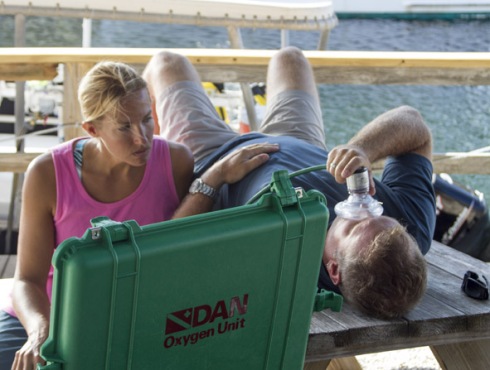Written by John Lippmann Founder & Chairman DAN Asia-Pacific
In-water recompression (IWR) has been used in one form or another for many decades as a means of trying to eliminate symptoms of decompression sickness (DCS). Historically, it was predominantly used by diver fisherman in places where there was no access to recompression chambers or suitable medical care.
Protocols varied, but it often involved descending to depth (often 30-50 m) breathing air. The reality was that it was fraught with risk for both the diver and his buddies and there are many anecdotes of poor and sometimes tragic results.
In an effort to reduce the depth required for IWR, several organisations introduced IWR protocols which used oxygen, rather than air, as the breathing gas. Possibly the best known procedure was that introduced by Dr Carl Edmonds, of the Australian Navy School of Underwater Medicine.
The treatments involve the injured diver re-submerging to a specified depth (usually 6-9 m) for scheduled times breathing 100% oxygen. However, the breathing of oxygen can cause seizures at these pressures so, to mitigate the risk of drowning in the event of a seizure underwater, the diver is advised to wear a full face mask. In the Edmond’s procedure, the diver is also tethered to a shotline marked in 1 metre increments to control the depth and later the ascent rate (which is 1m / 12 minutes). There needs to be an underwater attendant with the diver and one on the boat. The sea and weather conditions need to be suitable and the diver needs to be wearing an appropriate wetsuit or drysuit to ensure that he/she doesn’t get cold during the several hours underwater. The treatment time ranges from about 2 to 3.5 hours.
With the emergence of technical diving, the breathing of high oxygen concentrations underwater has become commonplace; as has diving in more remote locations. The availability of rebreathers enables oxygen-breathing for extended periods. As a result, there are an ever-increasing number of anecdotal reports of divers with symptoms of DCS treating themselves using IWR on oxygen (IWOR). If done in a reasonable fashion, this is often successful. However, the reality is that it is often done in a relatively haphazard manner, increasing the risk of a problem.
Over recent months, DAN AP has received two concerning reports involving IWOR. The first involved a technical diver who was diving in Indonesia. He developed mild symptoms of DCS after diving and decided to do a shallow dive on his rebreather on a high PPO2 to try to resolve them. Although the symptoms receded for a while, they worsened again that evening. After searching the web he found some IWOR procedure on a chatline and dived again the next day, trying to treat his symptoms. Unfortunately, they became far worse and he further compounded them by flying home.
The second diver developed symptoms of decompression illness after diving from a ’liveaboard’ in the Philippines. He was unconscious for a short time. The dive crew called the DAN AP Diving Emergency Service (DES) hotline and was linked to an experienced diving doctor. The operator indicated that its protocol was to use IWOR and asked the doctor for advice. The doctor advised that the diver should NOT be put in the water due to his unstable condition and that he should remain on the boat and breathe oxygen for several hours while arrangements could be made for further management. The diver improved significantly with the oxygen first aid, but, despite this and against the medical advice, the dive operator insisted that the diver do IWOR. Had he become unconscious whilst underwater it could have ended in a fatality and the dive operator’s position would likely be indefensible given that they had acted contrary to expert medical advice.

It is not the role of a dive professional to make what is essentially a medical decision to perform IWOR on a client. Unless they are particularly well-informed, the client would not be in a position to assess the potential risks and balance them against the possible advantages. This is also true of the dive professional.
I believe that IWOR has its place in the management of DCS in remote places. However, it must be done using acceptable protocols, with appropriate equipment, in appropriate conditions and only on a diver who is conscious and stable. Expert diving medical advice should be sought and followed.
Dive operators and divers should not underestimate the effectiveness of properly delivered surface oxygen first aid. If given early, in high enough concentrations and for long enough (often 4-6 hours), oxygen first aid will often reduce or eliminate symptoms of DCI. It is essential that there is an adequate oxygen supply that will last until medical aid is available, or until a diving doctor advises that it can be ceased.
DAN Asia-Pacific Safety Tip: In-Water Recompression | PADI Pros Oceania:
'via Blog this'

